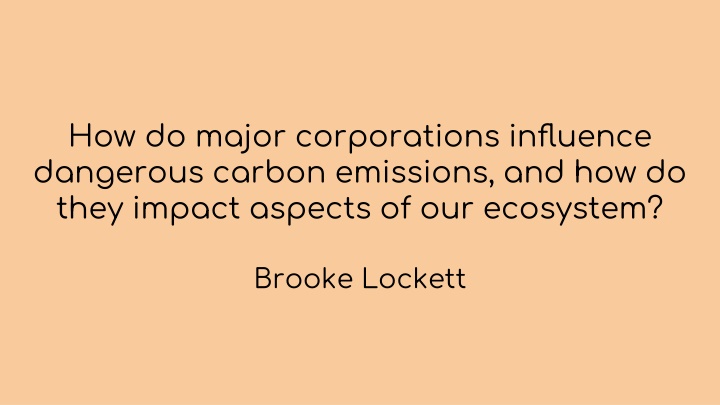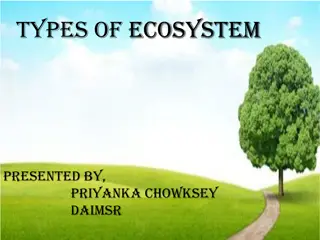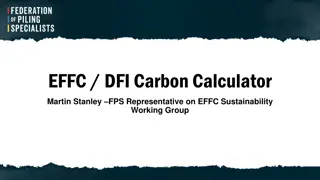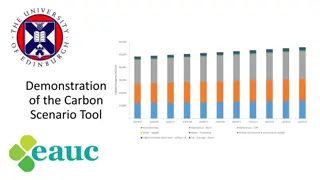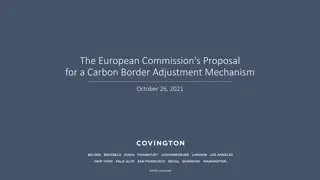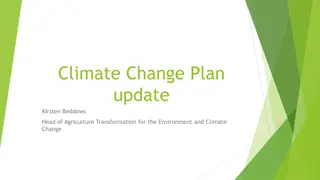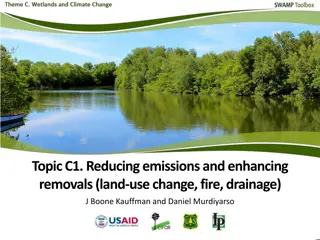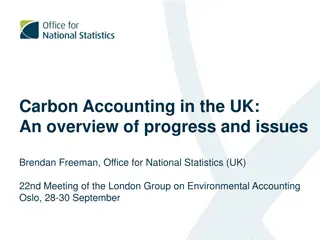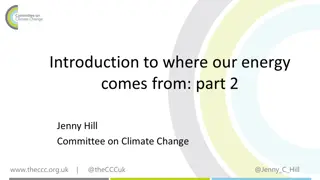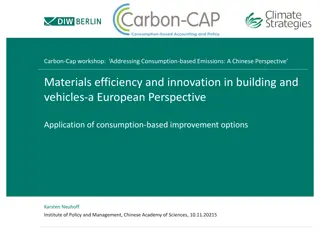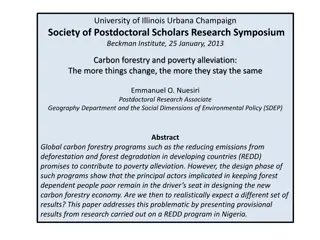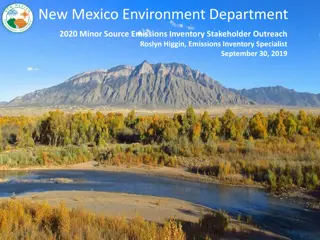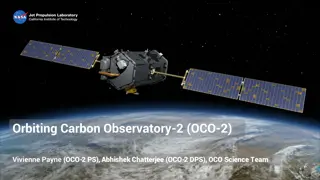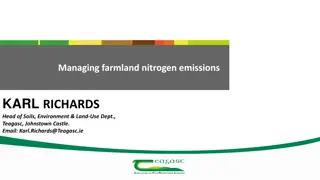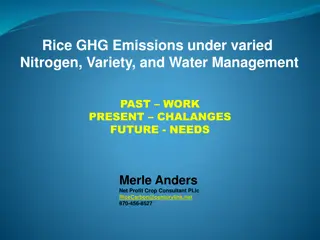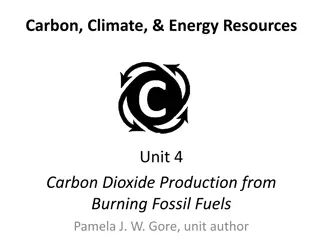Impact of Major Corporations on Carbon Emissions & Ecosystem
Technological advances and corporate actions significantly influence carbon emissions, leading to ecosystem disruptions like climate change and ocean acidification. Major corporations play a pivotal role in shaping environmental challenges and solutions through their manufacturing practices and emissions contribution.
Download Presentation

Please find below an Image/Link to download the presentation.
The content on the website is provided AS IS for your information and personal use only. It may not be sold, licensed, or shared on other websites without obtaining consent from the author.If you encounter any issues during the download, it is possible that the publisher has removed the file from their server.
You are allowed to download the files provided on this website for personal or commercial use, subject to the condition that they are used lawfully. All files are the property of their respective owners.
The content on the website is provided AS IS for your information and personal use only. It may not be sold, licensed, or shared on other websites without obtaining consent from the author.
E N D
Presentation Transcript
How do major corporations influence dangerous carbon emissions, and how do they impact aspects of our ecosystem? Brooke Lockett
Intro and Overview Technological advances during the digital age have disrupted the balance held in our relationship with nature, yet simultaneously they could also be the solution to rebuild this structure. Modern society manufacturing technology is releasing carbon dioxide emissions through the burning of fossil fuels, resulting in devastating long-term effects. Global crises serving as examples of the consequences of non-regulated carbon emissions include ocean acidification, climate change, and irregularities within the food chain.
Background The Industrial Revolution rapidly began to rise in mid to late 1970s, dominating every major industry and steering manufacturing towards a more efficient, consumer- oriented economy. LT Positive effects - Faster output, employment opportunities, innovation, health advancements, quality of economic life LT Negative effects - Rapid increase in air, land, and water pollution, exploitation of natural resources, worker exploitation, normalization of dangerous working conditions Methane, Nitrous Oxide, and Carbon Dioxide concentrations have risen to a never before seen level due to anthropogenic factors. *Human actions* Greenhouse Gases
Companies Role It has been found that around two-thirds of carbon emissions have come from 90 well- known investors and state-owned fossil fuel companies (Licker et al. 3). Chevron, ExxonMobil, Royal Dutch Shell, Peabody Energy, ConocoPhillips, Saudi Aramco, and Gazprom are some of the highest and well-known contributors (Licker et al. 3). Eco-Friendly processes of manufacturing could have been put into place using renewable resources to counteract the carbon emissions, Tracing Fossil Fuel Companies Contribution to Climate Change and Ocean Acidification however companies instead devoted time, money, and attention to deceive the public rather than assisting solutions counteracting their impact. (Licker et al. 3)
Climate Change, Specifically Global Warming Anthropogenic factors since the industrial revolution have significantly shaped the way the atmosphere is able to absorb and regulate how much carbon dioxide it has been exposed to. As the sun s energy reaches the Earth, it is absorbed and transferred into heat. However, greenhouse gas emissions create a block in our atmosphere, prohibiting this heat energy from escaping, trapping it within the gases and reflecting onto us. During this global warming period, the change in mean temperatures have risen 33 degrees fahrenheit. Effects on Ecosystems (Tkacik) Marine and terrestrial animal species are struggling with environmental changes Traits of natural schedules within species lifespans are disrupted Extreme weather patterns are occurring
Ocean Acidification The majority of heat not able to be absorbed by land is stored within our oceans, which holds the extra solar radiation for long periods. Over one-third of CO2 trapped in the atmosphere is absorbed by the large bodies of water. Marine life species are not naturally able to self-regulate pH levels within their biological processes if levels exceed capacity, and as a result many key needs are affected. Regulatory Mechanisms Physiological Processes (Ion, Enzyme, Protein functions) Inability to properly form calcium carbonate shells, and carbonate skeletal structures Changes will modify stable relationships within the marine food chain, creating a threat to biodiversity. Disruptions to our economies and food sources Fisheries and seafood focused companies will evidently suffer Quality and supply of seafood will decrease Jobs will be lost
Solutions Negative Emission Technologies Carbon Capture and Storage (CCS) (Nelthorpe) -Mitigates the inflow of emissions within the atmosphere, and allows carbon to be stored straight from any main source of CO2 emissions. Direct Air Capture (DAC) -Aids in completely removing carbon emissions, chemically extracted from air then compressed. The Congressional Research Service lists Enhanced Oil Recovery (EOR) as the most current use of captured carbon. In EOR, compressed CO2 is injected into aging oil wells. This process increases oil production while also permanently sequestering some CO2 (Lawson, 1) Reducing carbon emissions on a personal plane by shifting to a clean, green lifestyle. This may include recycling, reducing waste, switching to renewable energy, or limiting fuel-driven transportation.
Conclusion carbon footprint. Major industrial corporations processes of production are leaving an irreparable Analyzing the current state of Earth gives us a glimpse into the future, where unsustainable living conditions will deconstruct the composition of healthy living. We MUST act now, before the threat of extinction comes upon us. Humans use of technology during the digital age has continuously proven to be detrimental to nature and life within, however it also could be the answer to healing from our mistakes. Each person must be environmentally conscious, and aware of the consequences our actions have towards the global future.
Works Cited Lawson, Ashley J. Carbon Capture versus Direct Air Capture. Congressional Research Center, 2020, https://suny- new.primo.exlibrisgroup.com/permalink/01SUNY_NEW/18p88r/alma996923600404844. Accessed 2 November 2023. Licker, Rachel, et al. Tracing Fossil Fuels Companies Contribution to Climate Change and Ocean Acidification. Union of Concerned Scientists, 1 December 2019, http://www.jstor.org/stable/resrep24076. Accessed 2 November 2023. Nelthorpe, Tom. Direct Air Capture. Proximo Weekly: Direct air capture direct to market? 17 December 2021, https://www.proximoinfra.com/articles/8105/proximo-weekly-direct-air-capture-direct-to-market. Accessed 2 November 2023. Tkacik, Daniel. The Greenhouse Effect. How things work: The Greenhouse Effect. SciTech, 30 August 2010, http://thetartan.org/2010/8/30/scitech/greenhouse_gases. Accessed 2 November 2023.
